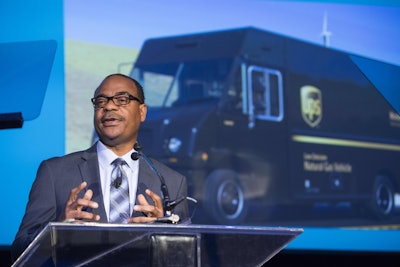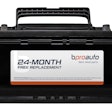
Carlton Rose, president of global fleet maintenance & engineering at UPS, said last week at ACT Expo that his company can’t get enough renewable diesel.
UPS announced last July that it will be increasing its use of renewable diesel 15 times over its prior consumption rate through new fuel contracts with Neste, Renewable Energy Group and Solazyme. Those purchases amount to 46 million gallons which UPS plans on using over a three-year period.
“We’re hoping that that commitment encourages bio-refineries and suppliers of feed stock. We believe that this could be a game-changer for the industry, but the speed of change will depend on availability,” Rose said during Tuesday’s general session for ACT Expo in Long Beach, Calif.
Renewable diesel continues to attract more private and public diesel users who say that biodiesel and conventional diesel can’t compete with the alt fuel’s high cetane value and ultra-low emissions. The California Air Resources Board (CARB) classifies renewable diesel as an ultra-low carbon fuel. Proponents, including UPS, say the nearly odorless and slightly tinted fuel also improves engine performance.
“The bad news is on the supply side,” Rose, the keynote speaker at Tuesday’s general session, told a large audience at the Long Beach Convention Center. “We can’t get enough of it.”
While interest in renewable diesel may be growing, The Association for the Work Truck Industry (NTEA) recently released results for its 2016 Fleet Purchasing Outlook Survey “which show biodiesel as both the current best-selling alternative fuel and the one with the most future interest.”
Renewable diesel is not biodiesel. The two fuels are derived from some of the same plant and animal fat sources, but it’s how those feedstocks are processed that makes all the difference.
Biodiesel is processed through transesterification, a chemical reaction that occurs usually through the introduction of an acid or base substance which renders the biomass liquid into an oxygenated, combustible fuel.
Neste, the largest supplier of renewable diesel in the U.S., uses a patented hydrogenolysis process to transform that same biomass liquid into fuel. It’s also known as hydrotreating in the petroleum industry. Neste produces renewable diesel in Europe and Asia.
“During this process hydrogen replaces other atoms such as sulfur, oxygen and nitrogen and converts the oil’s triglyceride molecules into paraffinic hydrocarbons,” states a report released by dieselforum.org.
The results are a non-oxygenated, more efficient and cleaner burning fuel, according to CARB. California is so impressed with the fuel that it announced in December that its statewide fleet would be switching from biodiesel to renewable diesel. Other fleets along the West Coast, including in Oregon and the State of Washington have been switching as well. California, the most populated state in the nation with a bustling trucking industry to match, has more renewable diesel stations by far than any other state.
Rocco DiRicco, deputy commissioner at New York City’s Department of Sanitation, told Hard Working Trucks that he’s interested in using renewable diesel in his fleet, but lack of availability precludes his department from doing so.
“We would love to be on renewable diesel by 2017, but I think that’s a little too aggressive,” DiRicco explained. “There is no renewable diesel available here yet, but we’re very anxious to start using it because of its benefits.
“We are in talks with the local supply chains but if anything it would only be a pilot program in 2017, if we’re fortunate enough to get started.”
Pat O’Keefe, president of renewable diesel company Nexgen Fuel, told Hard Working Trucks that demand continues to grow for renewable diesel and that it’s hard turning customers away—not because of a lack of availability, he explained, but because of a lack of legislation, which California has in place to make renewable diesel a more competitive choice.
“The only way to do it is legislatively, for New York, Florida, Kansas, or wherever you might want to be, is to say ‘We want a low carbon fuel,’” O’Keefe said.
“Mandate that you’re going to a lower carbon fuel, and what that does is that it forces the fuel slate to be lower carbon, and the lower carbon fuels that bring that whole slate down have more value. And so therefore, that creates value.”
However, O’Keefe cautioned that it’s best to test out the fuel before making any commitments. Nexgen can work with a fleet to create a pilot program.
Another attractive selling point for renewable diesel is that it shares the same chemical structure as diesel and therefore requires no engine modifications. Fleets that have had fuel system clogging problems with biodiesel report that clogging is not an issue with renewable diesel. The fuel also remains uniform during storage. Some fleets have complained that biodiesel does not.
Nexgen’s Nexdiesel high cetane number, which ranges between 70 to 90, allows for a cleaner and more efficient burn. The fuel, supplied by Neste, has been shown to reduce greenhouse gas emissions by 40 to 90 percent compared to conventional diesel.
Propel Fuels, a renewable diesel retailer with stations mostly in California, reports on its website that the alt fuel reduces NOx emissions by 14 percent, particulate matter by 34 percent and carbon monoxide by 13 percent when compared to petroleum diesel. Propel’s renewable diesel is supplied by Neste.
UPS has been using renewable diesel for over a year. No stranger to alternative fuels, the global delivery giant first began using electric vehicles electric vehicles in the 1930s, Rose said. The company continues to explore and use various alt fuels in about 6,300 of its vehicles.
“It’s better to be in the kitchen than on the menu,” Rose said.










